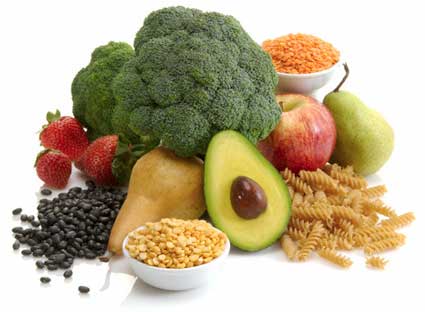
Dietary Fiber - For Diabetes, Heart and General Health
Most people understand the importance of dietary fiber in their diet. Much has been said about its importance in heart health, cancer prevention, and even weight control. What is less well understood is how different types of fiber benefit the diabetic.
Dietary fiber is broadly classified into soluble and insoluble fiber. Soluble fiber is fermented in the colon, and plays a role in slowing the absorption of glucose into the bloodstream. It also encourages the growth of the 'friendly' bacteria that help break down bile, and is involved in the creation of B vitamins like folic acid, niacin, and pyridoxine.
Insoluble fiber, on the other hand, acts a bit like an intestinal broom. It provides bulk to the stools, and makes sure they pass through easily and quickly. This is the type of fiber that keeps you 'regular'.
Moreover, insoluble fiber provides a feeling of fullness. This makes it great for weight loss by controlling hunger. It also keeps blood sugar levels more stable, although research into the rate at which carbohydrates enter the bloodstream have found there to be some significant differences within the foods that make up the fiber group. Dietary fiber can thus be rated by its glycemic index, which effectively ranks fiber foods with each other on a relative scale.
The idea is to try and include more low gylcemic index foods. Foods with a high glycemic index cause blood sugar levels to spike, providing too much energy to the blood in the form of carbohydrates, which in turn sets off the body's sugar controlling hormone - insulin. This leads to a 'high' followed by a sudden drop. This in turn leads the body to want more carbohydrates to balance itself again, leading to cravings and overeating, as well as tiredness and moodiness.
Low glycemic index foods include lentils, chickpeas, baked beans, fruit loaf, salmon sushi, barley, milk, low fat custard, soy milk, yoghurt (not diet yoghurt), apples, strawberries, grapes, spaghetti, peas, carrots, fructose, strawberry jam, and chocolate milk.
Moderate glycemic index foods include pea soup, rye bread, porridge, muesli, ice cream, bananas, pineapple, kiwi fruit, new potatoes, beetroot, white sugar, honey, and mars bars.
High glycemic index foods include broad beans, bagels, white bread, brown rice, watermelon, udon noodles, desiree, pontiac and sebago potatoes, and glucose.
We need both soluble and insoluble fiber, however. A study published in the American Journal of Clinical Nutrition found that in a group of 6000 French men and women, those with the highest levels of soluble and insoluble fiber in their diet had a lower risk of being overweight, a lower risk of having blood pressure problems, cholesterol problems, and they had better tricylglycerols (a triglycerides) and homocysteine levels.
Fiber from cereals was linked to lower body fat, lower blood pressure, and lower levels of homocysteine. Those with a higher intake of vegetables, also a source of fiber, had lower blood pressure and lower homocysteine levels. Fiber from fresh fruit was associated with a lower waist to hip ratio (good news for dieters!), and lower blood pressure. And fiber from dried fruit, nuts, and seeds (like sesame seeds, sunflower seeds, and pumpkin seeds) was also linked to a lower waist to hip ratio, lower body fat, and a better fasting glucose concentration. Fasting glucose relates to having a steady level of glucose between meals.
Fiber has another interesting benefit. In people with type 2 diabetes, it has been found to lower the levels of 'bad' cholesterol, and increase the levels of 'good' cholesterol. It has already been established that fiber supplements will lower the levels of bad cholesterol in people, whether they have diabetes or not. But this new study found that fiber supplements also decreased the reabsorption of cholesterol from meals.
To get this benefit, it is important to time taking the fiber supplement in synch with meals. The study participants took a fiber supplement drink before mealtimes, and this ensured that the fiber was in the intestines when the meal was being eaten. The people in the study participated for 90 days and their average age was 59 years old.
Our top fiber choices are:
Metagenics: MetaFiber® - 13.4 Ounces
Nature's Way: EfaGold® Hemp Protein & Fiber Powder 16oz
Related Article: The 6 Most Potent Supplements & Herbals for Glucose Control |









